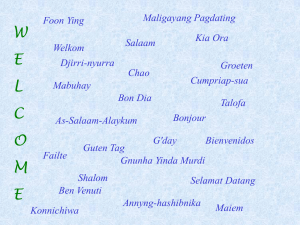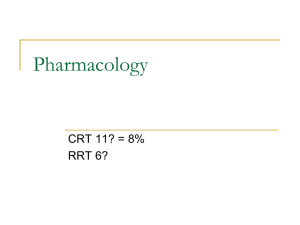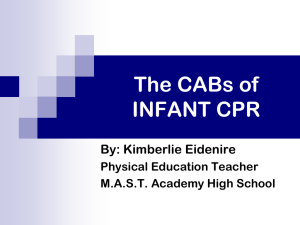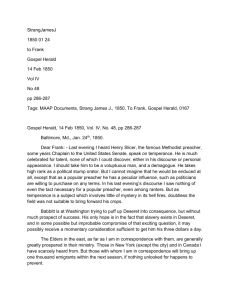thick inversion
advertisement
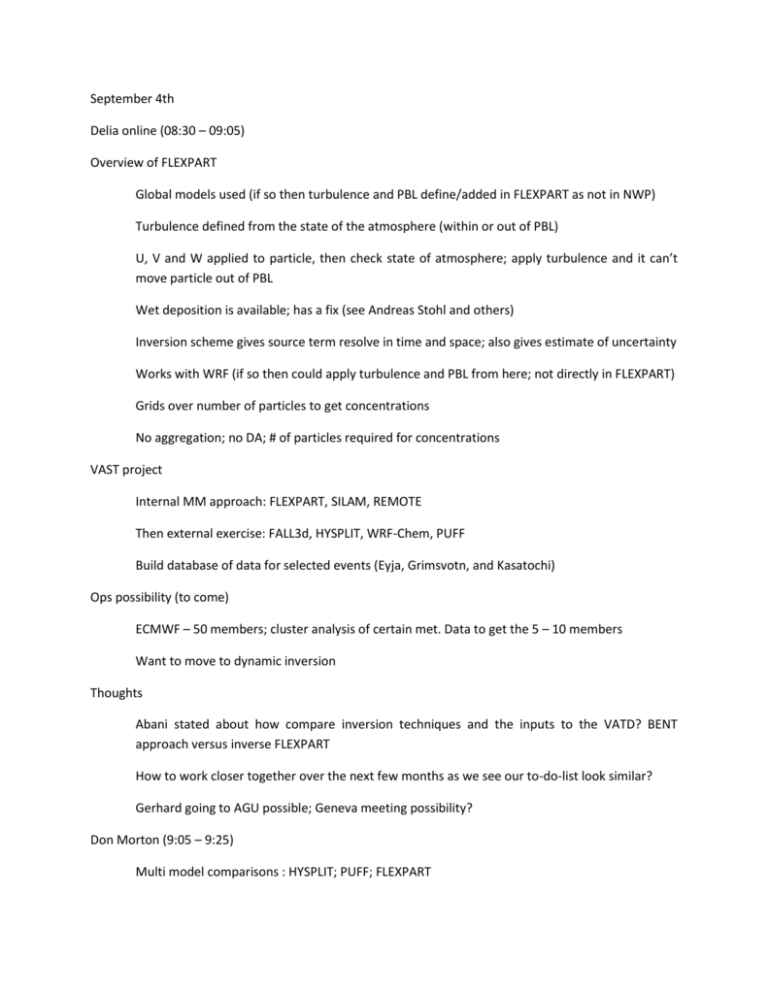
September 4th Delia online (08:30 – 09:05) Overview of FLEXPART Global models used (if so then turbulence and PBL define/added in FLEXPART as not in NWP) Turbulence defined from the state of the atmosphere (within or out of PBL) U, V and W applied to particle, then check state of atmosphere; apply turbulence and it can’t move particle out of PBL Wet deposition is available; has a fix (see Andreas Stohl and others) Inversion scheme gives source term resolve in time and space; also gives estimate of uncertainty Works with WRF (if so then could apply turbulence and PBL from here; not directly in FLEXPART) Grids over number of particles to get concentrations No aggregation; no DA; # of particles required for concentrations VAST project Internal MM approach: FLEXPART, SILAM, REMOTE Then external exercise: FALL3d, HYSPLIT, WRF-Chem, PUFF Build database of data for selected events (Eyja, Grimsvotn, and Kasatochi) Ops possibility (to come) ECMWF – 50 members; cluster analysis of certain met. Data to get the 5 – 10 members Want to move to dynamic inversion Thoughts Abani stated about how compare inversion techniques and the inputs to the VATD? BENT approach versus inverse FLEXPART How to work closer together over the next few months as we see our to-do-list look similar? Gerhard going to AGU possible; Geneva meeting possibility? Don Morton (9:05 – 9:25) Multi model comparisons : HYSPLIT; PUFF; FLEXPART Mike P (09:30 – 11:30) 2-D maps of mass loadings, effective radii and optical depth Has his optimal estimation of this data Can we use optimal estimation to classify uncertainties for Puff re-start Use Puff area source capabilities Can we use optical depth to help class its vertical shape? Could Puff vertical distribution be used to define how to ‘spread’ the mass is in the vertical? Could we define a set of vertical shapes as a classification of uncertainty of what we can define Could we use past events to define the top and bottom, maybe 1 km thick cloud? Mike height, mass loadings would be used to help tune Puff height and mass at the timing of the image data Puff needs 4e6 particles before we statistically start to see the cluster of ash mass around these thin layers Can we use satellite known boundary limits of g/m2 and set this in Puff and look at probabilities of both spatially in this combined regions Mike information will give you an idea of other clouds that could obscure satellite and so we could use this to help to determine if we should forecast this part of Puff forward (as long as it breached the same detection limit that the satellite is known to have) Set Puff mass loading to limit of satellite, compare loadings, if satellite does not see anything in a location and Puff does above limit of satellite, could use Mike’s other cloud information to determine if we should move this forward? Also would help to see if Puff height is below the cloud The aim is to use the satellite data to help determine which parts of Puff to move forward If we did gap fill, what is probability threshold to use to say yes we will use Puff? Mike’s work did only look for gap fill where we knew that obstructing clouds occurred. How to use satellite data? 1. Gap filling 2. Image ash move model forward 3. Inverse problem for ESP Do we combine them together? Use inverse approach for the first few hrs and use satellite to help define ESP, add a lot of ensemble members to this new ESP and propagate forward. Then after first few hours, do the model re-initialized Satellite gives cloud top height, total mass, define a 1km cloud thickness, uniform in vertical as Puff has limit of 1km vertically in concentration data. How can we look to those cases where Puff is so far out from actual that we want to launch Puff from the satellite? Can we use the Figure of Merit in Space analysis to determine how well Puff matches to satellite? Then if good match, we can do inverse. If poor match then we say Puff has too many errors and we ‘throw it out’ and move forward from satellite only Tropical case – Ruang 2002; Mike has satellite data that he could provide for that Arctic case – Kasatochi 2008; but ocean fallout so add in some of Redoubt 2009 with land based fallout Could add in other volcanoes in the region (one that had fallout on land) – Marcus can find out for Tropics from Newhall Bruce brought up how to do the true assimilation – Mike has probability of ash in a pixel and then uncertainty estimation of mass loadings; it has been corrected for look angle so it is as if it is truly vertical Mike spoke on looking at how atmospheric community to assimilation of aerosol data into NWP Given the satellite information and its defined uncertainty estimation we can then build a new ensemble from this new data Rorik (12:40 - ) Open MP Puff is now on the sourceforge branch from Rorik Loops were made open MP for the different particles Most of work on the random number generator and making it open MP; also had ability to use the random number generator built with the C++ and this is thread safe New reanalysis files can now work with Puff Found interpolation method for particle location can be done faster; fixed this and converges a little faster than the previous bi-linear spline Seems to run well on 16 cores, I/O work is around single digit % of time so not real big improvement Needs NWP on regular grids; cant taken WRF Arkawwa C-grid Discussion on aggregation possibilities Particles right now work independent of each other Would need to build system to know of proximity to each other so under mean free path could particle come together ATHAM brings in code on rain drop tools; could this be brought in? Area source/run Puff of satellite/ATHAM model Could we run ATHAM and Ben-Puff for an event; use ATHAM to write a Puff netcdf file for Puff to read in? We would want to output ATHAM at the same time as Bent-Puff and run forward from this Also we could write 3D Puff netcdf out from ATHAM and run forward Area source is good off satellite data; Rorik wrote this for AirForce for restart off satellite Area source would need some work to really get the fully capability needed off the satellite data; this tools allows you to find shape and then say to Puff put in say 40e6 particles and Puff itself will place the particles via random walk locator Might be easier to read Puff netcdf output; offline do the comparison and the analysis; then re-make a new Puff input netcdf file that has been updated and re-run Puff from this ‘fixed’ file Puff netcdf input/output file format does not need to be kept and as such it can updated if there is a more efficient way to store data; this might be a question that comes up from the DA off satellite; also on the ATHAM/Bent-Puff analysis and then generate Puff input file Open MP on the inside for the running of 4e6 particles; MPI runs for the different ensemble members using Matt’s code Could we build a version of Puff that is ‘Ensemble mode’; this might be Puff + the Wrapper tool that allows the user to define if ensemble or stand-alone; we would not build directly into Puff would be more a Python wrapper on top like based on MPI and data sharing on memory. 2-3 page document on planning document for puff model/data marriage Operational Puff – how to handle aggregation and wet deposition Aggregration could be resolve in ATHAM-Puff link; run ATHAM to +/- 50 km and then run Puff off output; ATHAM would take care of aggregation; but would take a long time We could do wet deposition truth reading met information and then determine if ice/water coated and change mass of the tracer based on atmospherics per time step in its region Do some test runs 1. Puff 2. Bent-Puff 3. ATHAM-Puff see significant differences and what we loose from using Bent-Puff only Papers GRL paper; with Romana and Abani and then all will look at JCP paper – with Reza and then submit soon To do Royal Soc/AAAS paper on the project work Covers ESP ensemble; Covers NWP ensemble; Inverse approach What is the workflow; how to move to operations MM model/Simple VATD and capture the variability within the Ensemble NWP for probabilities of volcanic ash mass
